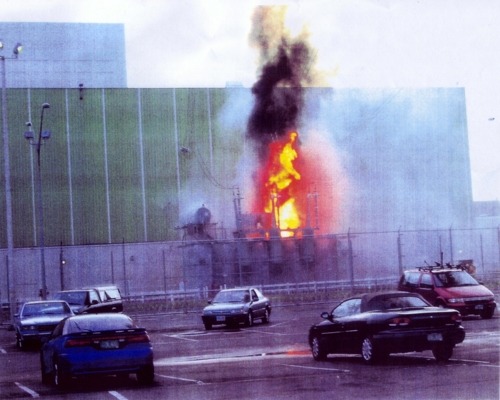 Figure 1.
Figure 1.
Over 40 years ago, James Taylor released a hit song about having seen fire and having seen rain.
In recent years, the Vermont Yankee nuclear plant experienced its own form of fire and rain. It experienced fire on June 18, 2004, when one of the connectors on top of the main power transformer linking the unit’s electrical output with the power grid failed. The connector’s failure resulted in two things: (1) electrical sparks from the failed connection, and (2) oil dripping from a flange near the connection. If oil and water don’t mix, oil and electrical sparks mix even less well. Figure 1 shows the fire atop the damaged transformer at Vermont Yankee.
The main generator produces electricity that is transferred via three metal bar conductors, called phase buses, to the power transformers. The buses attach to the transformers with flexible connections designed to accommodate movement caused by the expansion and contraction of the metal bars as they heat up and cool down.
While workers periodically examined the buses for wear and tear, they did not inspect the condition of the flexible connectors. Pieces broke off a degraded flexible connector and grounded one of the three phase buses. In other words, the metal flakes created a pathway for electricity to flow not to the transformer but into the metal ductwork surrounding the bus. Workers at other plants experienced aging of the flexible connectors and distributed information within the industry about this problem and its solution. But workers at Vermont Yankee did not heed these warnings until after this fire.
The grounding on one bus increased the electric current flow through another one of the buses. This bus was equipped with a surge arrestor to protect against this situation. But the surge arrester was already broken. Unlike the buses, workers were not checking the surge arrestors for wear and tear, so they wore and tore until they broke. And since workers never examined the condition of the surge arrestors, this one’s failure remained undetected until it helped create a very visible sign.
Rain was experienced on August 21, 2007, when one of the two cooling towers at Vermont Yankee partially collapsed. Fabrication errors during a structural modification to the tower weakened it until the weight of the water flowing through a large distribution pipe was too much for one section to bear. That section collapsed, shearing off the distribution pipe. Water pouring from the broken pipe is shown in Figure 2.
This was not the only cooling tower problem the plant faced. It experienced three significant cooling tower events in about two years all caused by fabrication errors.
 Figure 2
Figure 2
Our Takeaway
The transformer fire could have been avoided had workers heeded lessons learned by workers at other nuclear plants. Those lessons were distributed to Vermont Yankee. But rather than acting on that information, workers reacted to it after the fire as part of their measures taken to prevent the next fire.
Perhaps the first cooling tower problem was unavoidable. But the next two events happened because the initial fix had been too narrowly focused to solve all the existing problems.
In each case, information existed that – if acted upon – could have prevented problems at Vermont Yankee.
“Preventative maintenance” is a standard program at nuclear power plants. At top performing facilities, it features maintenance performed to prevent problems. At other facilities, it prevents maintenance from happening until after problems manifest themselves.
“Fission Stories” is a weekly feature by Dave Lochbaum. For more information on nuclear power safety, see the nuclear safety section of UCS’s website and our interactive map, the Nuclear Power Information Tracker.
